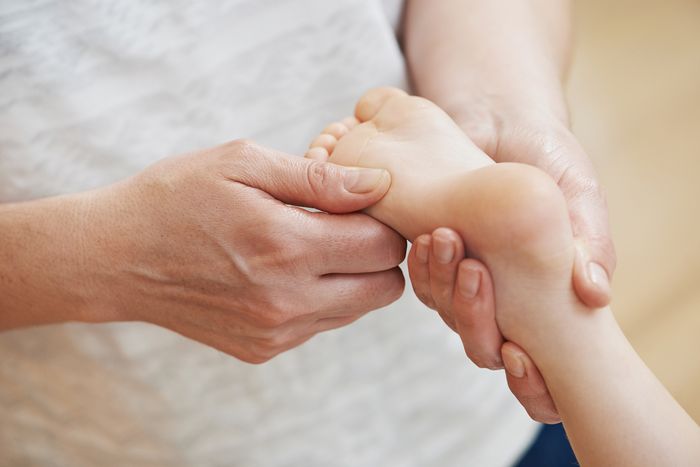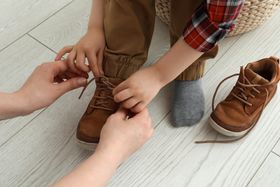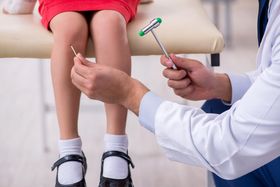Toddler Feet Growing Pains: Here’s How You Can Help
Published July 18, 2023.

Are you looking for answers concerning your children's growing pains in their feet? We understand that these episodes of pain can be quite bothersome since they can be distressing for both the kid and the parents. But it's important for you to know that you're not alone. An extensive study on growing pains among children found that 37% of children aged four to six years have growing pains.
We'll make it easier for you to look at the reasons for these growing pains, how to identify them, and how to treat them effectively so you can have a better grasp of the condition and the skills to help your toddler in finding relief. So let's dive in and explore this topic together!
Understanding Toddler Feet Growing Pains
Ever wondered what growing pains feel like for your child? These aches are generally harmless and are believed to be triggered by the natural growth and adjustment of muscles, ligaments, and bones in their feet. Although the exact cause of growing pains remains a mystery, they're a common occurrence, impacting many children between the ages of 3 and 12. It's crucial to remember that growing pains in the feet are a normal part of a child's development and usually dissipate on their own.
» Get your kid excited about wearing shoes
Identifying Growing Pains in Toddlers
Growing pains can sometimes be misinterpreted as more severe conditions like plantar fasciitis or other foot-related issues. Thus, it's important to distinguish the symptoms.
Signs and Symptoms of Growing Pains
Here are some common signs if your child is going through growing pains:
- Recurring Pain: Growing pains often manifest as intermittent discomfort in the bottom of the foot.
- Generalised Pain: Children may experience an overall uncomfortable or achy feeling in their feet.
- Discomfort in both feet: Growing pains usually affect both feet equally, instead of being localised to one foot.
- Cramping or Throbbing Sensations: Kids often describe the pain with phrases like "my feet hurt" or "my feet feel funny". They might also use words like "squeezing" or "tightness" to describe the cramping sensation, while "pulsing" or "beating" may refer to a throbbing sensation.
- Restlessness and Difficulty Sleeping: Growing pains tend to worsen at night, leading to restlessness and sleep disruptions for some children.
» Is your kid walking bowlegged? Learn more about baby leg development
Differentiating Growing Pains From Other Foot Conditions
While growing pains are common and temporary, it's crucial to recognise that some symptoms may suggest a more serious issue that isn't just growing pains. If your child displays any of the following signs, it's recommended to consult a healthcare professional:
- Localised pain in one area of the foot: Growing pains typically affect both feet and aren't limited to a specific area. If your child complains of pain in a distinct area or if the discomfort is confined to one foot, it's critical to get it evaluated.
- Severe and Prolonged Pain: If your child has severe or persistent foot pain that interferes with their daily activities or lasts for an extended period, it's advisable to seek medical assistance.
- Pain that is Worse in the Morning: Growing pains usually strike in the evening or at night. If your child experiences foot pain that's worse in the morning or upon waking, it's worth getting it checked out.
- Swelling, redness, and/or warmth: Growing pains rarely result in noticeable inflammation in the foot, like swelling, redness, or warmth. If these symptoms accompany your child's foot pain, it's crucial to get a professional evaluation to rule out any underlying disorders.
» Learn how to measure your child's feet for shoes
Growing Pain Treatments for Toddlers
If you're at your wits' end about what to do for growing pains in ankles, feet, and legs. Here are some simple and safe measures that you can adopt at home to get rid of growing pains or at least alleviate them:
- Gentle Stretching of the Feet and Lower Legs: Encourage your child to do mild stretching activities that target the muscles in the feet and lower legs. This can aid with flexibility and tension relief.
- Foot Massages: Gently massage your child's arches, heels, and toes using circular motions. This could help soothe their discomfort.
- Applying a Warm Compress or Taking Warm Baths: The heat from a compress or a warm bath can relax their muscles and provide temporary comfort. Ensure the temperature is both pleasant and safe for your child.
- Wearing Appropriate Footwear: Appropriate footwear is key in supporting your child's feet as they grow. Opt for shoes that are well-fitted, supportive, cushioned, flexible, and specifically designed for a growing child. First Walkers offers footwear that meets these criteria and offers maximum comfort and support.
- Balanced Diet and Proper Hydration: A well-rounded diet rich in key minerals like calcium, vitamin D, and magnesium aids healthy bone and muscle growth.
» Check out our list of shock-absorbing shoes for active kids
Pain-Free Feet Are a Few Steps Away
Understanding the signs of growing pains in your toddler's feet is essential to providing the care they need. This is a common hurdle many children face as they grow. By adopting basic measures like gentle stretching, foot massages, and wearing proper footwear, you can effectively manage your child's growing pains.
However, if the pain persists, escalates, or becomes severe, it's paramount to seek medical advice. Remember, every step towards easing your child's growing pains is a step towards healthier growth.





